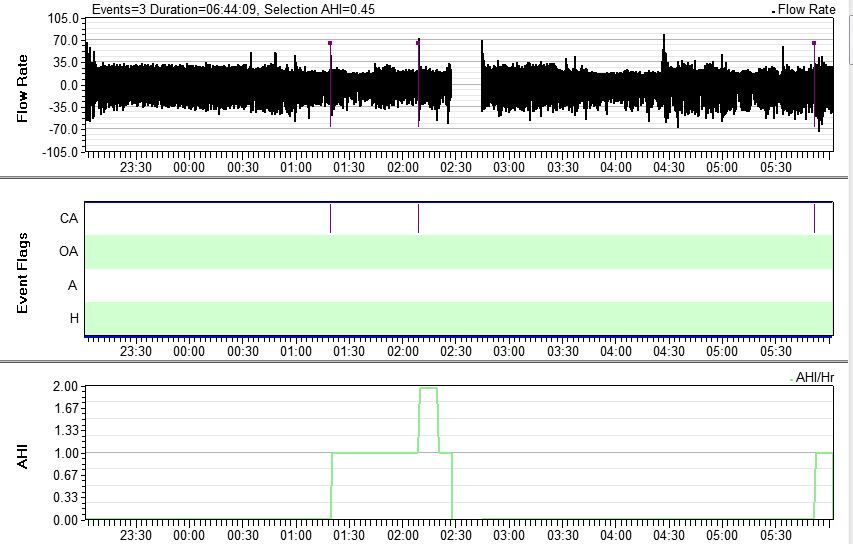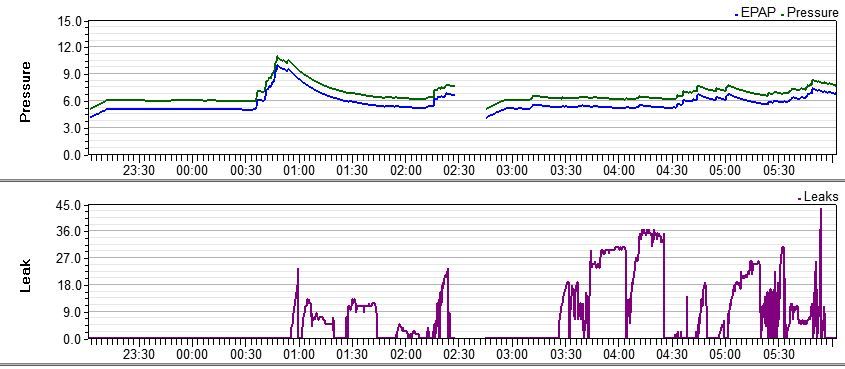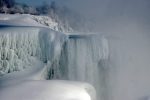DJL wrote:
Recently (ie months) have still been feeling very tired and have been having mask leaks, tried numerous masks but end up on Aloha pillow.. A few nights ago I bought a CPAPmax pillow to try to prevent mask from resting on pillow. The Average Rate is 6.61(down from 10.5) and the 95% leak is 30 (down from 37). Leaks are worse later in the night when I must be moving around more.
Leaks late in the night can also be worse because our faces are more relaxed (and hence more slack) late in the night than they are when we first mask up and work on the seal.
On the leaks: You're using a Resmed S9. The machine reports only the excess leak in the leak data. In other words, an absolutely perfect leak line would be at 0.0 L/min all night long. But note, most people don't have an absolutely perfect leak line all night long, night after night. The goal is to get a good leak line (no large leaks) and have the remaining leaks not be bothersome enough to wake you up. Resmed defines a "large leak" as any leak over 24 L/min and ResScan draws a Red Line at 24 L/min so that large leaks are easy to spot
On the night you've posted the data for, your leak rate is over magic Red Line of 24 L/min for at least 45 minutes it looks like. It looks like you have about an hour of time spent with the leak rate ABOVE or VERY NEAR the Red Line. You used the machine for about 6.75 hours. So about 15% of the night, your leaks were either in Large Leak territory or pretty close to it.
Do you ever have nights where Mr. Red Frowny Face shows up the next morning on the machine's LCD Sleep Quality Report? If Mr. Frowny Face is paying you visits, then leaks are definitely issue. Mr. Frowny Face shows up when you spend at least 25% or 30% of the night with the leak rate AT or ABOVE 24 L/min. At that point, the Resmed engineers are worried about both the efficacy of the therapy and the accuracy of the data.
If Mr. Red Frowny Face not shown up, then the question becomes: Are the leaks disturbing you?
So----if this is a typical night and the leaks are at least somewhat bothersome (or you just don't feel very well), then working on the leaks is likely worth it.
I am still trying to learn how the graphs tie up with each other. My AHIs for the night were 0.45 (ie good), but when I look at when they occurred (1.20am to 2.30am) the pressure is near my range low setting of 6cm. About the same time there are mask leaks but seem to be spiking at the 24 l/min which I think is acceptable. In fact later on during the night(3.30 to 6am) the leaks are higher but a lot less AHI activity.
All three of the events the machine scored on this night are classified as
Central (clear airway) apneas. The Auto algorithm does NOT increase pressure because of CAs---even clusters of CAs. Since the airway is already open, increasing pressure is not needed to provide additional support for propping open an airway that's demonstrating its ready to collapse.
As far as the mask leaks are concerned: Yes, there's some leaking going on around the CAs scored in the 1:20--2:30 am time frame. But the leaks do seem to be below 24 L/min here and hence there's good reason to believe the data is reliable: In other words, these events likely did happen and it's likely that no other scoreable events occurred during this time frame.
Later in the night? You have a 45-minute period (roughly 3:45--4:30 am) where the leak rate is pretty consistently AT or ABOVE 24 L/min. The event data from
that particular 45 minute period might not be particularly accurate. In other words, it is possible that some events occurred but went undetected by the machine due to the excessive amount of LARGE leaking going on. In other words, because of the significance of the size of the leak and the length of time the leak was present, we need to acknowledge the possibility that some events may have occurred but not been scored. Between 4:30 and 6:00, the leak rate seems to stay strictly below the 24 L/min Red Line. So the data is probably pretty clean (i.e. it's likely that the only event you had was the one CA scored at about 6:15am), but there's always a chance that the machine might misscore an event here and there.
The flow rate seems to be pretty consistent between plus/minus 35 (not sure if this is an acceptable range).
Flow rate is just the measure of how much air is actually moving in and out of your lungs with each and every breath. When the flow rate is NEGATIVE you are exhaling. When the flow rate is POSITIVE you are inhaling. The range of values for flow rate is going to depend on how big you and your lungs are and what your usual night time breathing looks like. Typically the max and min values for flow rate during periods of sleep breathing are (much) closer to 0 than the max and min values for wake breathing.
Could people look at these graphs and tell me if there is anything that jumps out at you as being good or bad and any suggestions would be helpful.
On this night your OSA was exceptionally well controlled during the periods when your leak rate was below the 24 L/min Red Line. Three well separated CAs scored during the entire night is just not something to lose any sleep over.
The leaks are problematic enough during the late night where there could be some problems with the accuracy of the data, particularly between 3:45 and 4:30. It may be worth putting some time and effort into doing some trouble shooting to bring the worst of the leaks under control. And by "under control" I mean one of two things: (1)Get the long leaks well under the 24 L/min Red Line and/or (2) reduce the length of time spent above 24 L/min to a few short lived spikes here and there.
Given the amount of leaking late in the night, it's also worth asking the question: How much do the leaks seem to interfere with how you perceive the quality of your sleep? If you're waking up tired and feeling less than restless, the leaks might explain why. If you are waking up with a dry mouth or nasal passages that are uncomfortably dry, the leaks would explain that. And fixing the leaks would make you feel better.
Finally, you might just be dealing with some significant mouth breathing issues since the leaks seem to start well after you turn the machine on (both at the beginning of the night and after the middle-of-the-night off/on cycle that is obviously associated with a wake). Do you ever find yourself waking up with lots of air rushing out of your mouth? If you have a bed partner, it's also worth asking them if they noticed any air rushing out of your mouth in wee hours of the morning.
One question I did ask on another topic was my lower pressure setting (but did not include graphs), my pressure during the night is bouncing along my lower pressure setting.
There's nothing wrong with your pressure bouncing around your minimum pressure setting when you have event data that looks like yours. The combination of the pressure curve and the events table indicates that 6cm of pressure is enough to excellently control the
obstructive events. Hence there's not much reason to increase the pressure. My guess is the pressure increases are in response to changes in the
flow limitation curve or the
snore curve which you did not post.
Some say that if you go too low it can start causing more AHIs. Besides trial and error is the anything in the graphs which point to the need to lower my pressure or leave it where it is).
If the minimum pressure setting is set too low, then events must occur
before the machine will increase the pressure enough to provide sufficient protection. My guess is that you probably have a titrated pressure (i.e. a "fixed" pressure setting as determined by the lab) of about 6 cm. If you were using straight CPAP instead of APAP, the pressure would sit at 6cm all night long.
It's quite possible that if you lowered the minimum pressure to 4cm or 5cm, you'd still have excellent control of your OSA. The AHI might increase from 0.5 (about what it is on this night) to maybe 1.5 or 2.0 since some events might get through before the machine raised the pressure enough to provide the excellent control that that your current 6-8cm range providing. For many people, there's no big difference in how they feel after a night with a 0.5 AHI vs. how they feel after a night with a 3.5 AHI. But for other people, there's a huge difference.
Should you decrease the minimum pressure to 4cm or 5cm? The answer depends on what you hope to gain by lowering the minimum pressure.
If you are not fighting aerophagia and
you can get the leaks under control at your current pressures, and you have no other "comfort issues" with the current pressure settings, then there is no good reason to change them. [The old saw "If it ain't broke, don't fix it" comes to mind.]
If you are fighting aerophagia or other comfort issues which you believe may be tied to the pressure, then a trial reduction in minimum pressure may be a worthwhile experiment. If you feel as though you are suffocating (because there's not enough air coming through the mask at 4cm or 5cm) or if there's an unacceptably large increase in AHI that persists for 4-7 days of the trial, then just bump the pressure back up to it's current 6-8cm range.
So to recap: If you are NOT experiencing any aerophagia or air-in-eye-through-tearduct probelms, then my advice is to work on the leaks at 6-8cm of pressure and try to get them a bit better under control during the second half of the night.
With my pressure being reasonable low, could I remove the EPR altogether, I read it tends to be more helpful when using higher pressures. I did have it on 3 (highest) and then went to 2 and now 1, until recently I did not realize that it can give false data or not control AHIs.
It's important to realize that the EPR is not affecting the exhale pressure setting as much as you think it is. Regardless of the EPR setting, the S9 will NEVER lower the exhale pressure below 4cm. Hence the affect of the EPR setting for 4--7cm H20 pressure is as follows:
Pressure level is at 4cm H20 and
- EPR = 3 means exhale pressure is at 4cm
- EPR = 2 means exhale pressure is at 4cm
- EPR = 1 means exhale pressure is at 4cm
- EPR = 0 means exhale pressure is at 4cm
Pressure level is at 5cm H20 and
- EPR = 3 means exhale pressure is at 4cm
- EPR = 2 means exhale pressure is at 4cm
- EPR = 1 means exhale pressure is at 4cm
- EPR = 0 means exhale pressure is at 5cm
Pressure level is at 6cm H20 and
- EPR = 3 means exhale pressure is at 4cm
- EPR = 2 means exhale pressure is at 4cm
- EPR = 1 means exhale pressure is at 5cm
- EPR = 0 means exhale pressure is at 6cm
Pressure level is at 7cm H20 and
- EPR = 3 means exhale pressure is at 4cm
- EPR = 2 means exhale pressure is at 5cm
- EPR = 1 means exhale pressure is at 6cm
- EPR = 0 means exhale pressure is at 7cm










